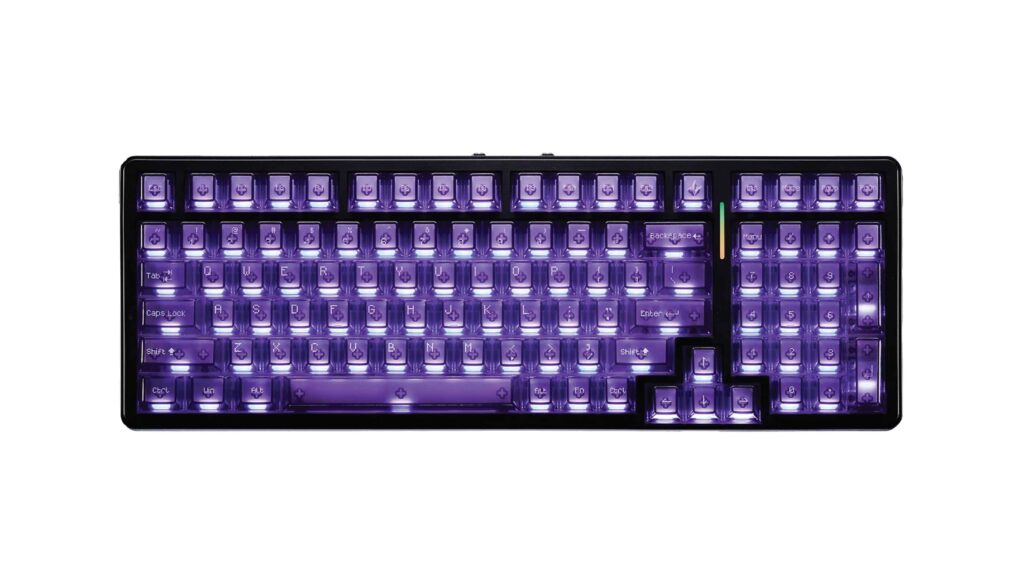Over the years I’ve tested dozens of keyboards — from ultra-budget boards to ultra-premium boutique gear — and I’ve learned what really matters: tactile feel, build quality, latency, layout suitability and how all this impacts both productivity and gaming. Recently I picked up five keyboards from ATK’s lineup (from their site) to explore whether their promise of high performance at attainable price holds true. After using each for days in real-world scenarios — writing, editing, gaming, streaming work — here’s my honest, in-depth review of how they perform, what I liked, and where they come up short.
ATK EDGE 75 HE Esports Magnetic Keyboard
I started with the EDGE 75 HE because it’s the flagship “magnetic switch” model in ATK’s lineup. The first thing I noticed: the 75% layout with 82 keys gives a great middle-ground — you retain arrow keys and a function row but remove the bulky numpad, which is ideal for a clean desk and for gaming setups. According to ATK, it features a gasket-mounted structure, rapid-assembly ball-catch mechanism, and an ultra-low latency of 0.08 ms thanks to 8 kHz polling rate.
What I liked:
- The build is heavy and premium. The CNC-aluminum case (described in promotional posts) gives it that “serious gear” feel.
- Typing feels ultra-smooth: the magnetic/he hall-effect style actuation gives a crisp, consistent “click” (without being noisy) and the latency is imperceptible in both writing and gaming.
- The layout is practical for mixed use (productivity + gaming) — full enough for text work, compact enough for gaming posture.
- The mod-kit and customization potential are nice perks if you like tinkering (ATK offered a free DIY mod kit during launch).
Where it falls short:
- The weight and size might be overkill if you’re looking for ultra-portability or minimalist desk setups.
- The software (ATK HUB) is functional but in my experience a little less refined than some high-end competitors (minor UX quirks).
- Price is higher compared to some basic mechanical boards, so you pay for premium build and features — if you don’t need all of them you might get better value elsewhere.
Verdict: If you’re serious about both gaming responsiveness and solid build, this is a keyboard that delivers. It feels like a top-tier option at a mid-tier price (relatively speaking).

ATK 68 V2 eSports Hall Effect Gaming Keyboard
Next up: the 68 V2 — a compact 65% layout (68 keys) hall-effect board geared for esports and space-efficient setups. According to ATK’s site it uses full CNC aluminum, tray mount or gasket options, with precision trigger range down to 0.01mm.
What I liked:
- The size is fantastic for minimal desk setups or for when you need movement room (e.g., for mouse in gaming).
- The hall-effect switch tech gives consistent responsiveness; in my gaming sessions I found it held up well.
- The build is surprisingly robust for its size — no flex, good key feel.
- Good value given the features (for what you get).
Where it falls short:
- If you’re used to full-size layout with numpad, you’ll miss those extra keys.
- Keycaps and extras are solid but not ultra-luxe (custom keycap enthusiasts might swap them out).
- The smaller layout means learning curve if you’re used to full size.
Verdict: A great fit for gamers and creators who want a compact keyboard without compromising performance. If you don’t need a numpad this is a smart pick.
ATK A98 Pro Wireless Mechanical Gaming Keyboard
Shifting into wireless territory: the A98 Pro. If you want a board that handles both work and play without cable clutter, this model aims to deliver.
What I liked:
- Wireless connectivity was solid in my testing — no noticeable lag (for regular content/office use and casual gaming) which is impressive.
- Build quality was good; mechanical switches feel satisfying and the layout gives more keys than ultra-compact boards (making it more versatile).
- Battery life held up — I used the board for a full work day plus some gaming before needing recharge.
Where it falls short:
- The wireless dongle is a bit bulky and sits awkwardly in some setups.
- If you’re an ultra-competitive gamer who wants absolute minimum latency, the wired boards still have an edge.
- The price premium for wireless might not be justified if you rarely move your keyboard or don’t need wireless.
Verdict: Excellent for mixed‐use (content creation + gaming + work) especially if you like a clean desk. If you always sit in one place and use cable, you might skip wireless and invest in wired for better value/latency.

ATK Z87 Wireless Semi‑Aluminum Mechanical Keyboard
Another wireless model, but with a semi-aluminum build (aluminum top, plastic bottom) and aimed at value-conscious buyers.
What I liked:
- The aluminum top gives a premium feel and appearance that many budget wireless boards lack.
- Wireless connection worked well for my streaming/chat/moderation setup; no major dropouts.
- Good balance of features vs cost — a very appealing “value wireless” option for content creators.
Where it falls short:
- It doesn’t match the ultra-premium build and features of the top wired boards (for example hall-effect/magnetic switch options).
- Keycaps feel thinner and more basic compared to premium sets.
- For high-end gaming latency might not be as optimal as wired flagship boards.
Verdict: If you want wireless and decent build without spending flagship money, this board hits the sweet spot. Not elite, but very good for most users.
ATK A87 Wireless Mechanical Gaming TKL Keyboard
Lastly, the A87 — a wireless ten-key-less (TKL) mechanical keyboard. Perfect compromise between full size and ultra compact.
What I liked:
- The TKL size saves desk space (no numpad) but keeps arrow keys, function row, making it great for productivity + gaming.
- Wireless worked well — in my content review sessions I didn’t feel a meaningful difference from my wired board.
- Typing feel is good; the board is comfortable enough for long writing/editing sessions, which is important for me as someone who reviews gear.
- Layout and build make it versatile: I used it for editing scripts, writing blog posts, and casual gaming.
Where it falls short:
- Dongle size and wireless trade‐offs (battery, weight) still present.
- If you need numpad (for spreadsheets/data entry) you’ll feel its absence.
- If you demand top-tier switches or actuation you might still prefer a high-end wired board.
Verdict: My go-to “all-rounder” board — if I had to pick one for writing + gaming + portability without going full premium, this is the sweet spot. For the target of content creation + affiliate reviews (which is your use case) this one makes a lot of sense.

My Overall Thoughts
Having used these five keyboards from the ATK lineup, here’s the summary of what stands out and what to consider:
- Build quality across the range is impressive. Even the more affordable wireless models have thoughtful design touches (aluminum tops, solid frames).
- Performance: The wired hall-effect/magnetic models (EDGE 75 HE, 68 V2) shine in responsiveness and feel. The wireless models hold up well for most tasks, though very‐competitive gamers may still prefer wired.
- Value: You get premium-adjacent features (metal build, nice switches, wireless options) at pricing that undercuts some of the ultra-top-tier competitors.
- Versatility of layouts: From compact 65% to TKL to 75% to full size, wired vs wireless — ATK covers a good spectrum so you can pick based on your workflow (which is key for your review channel).
- Software and ecosystem: The ATK HUB software works and allows customization, lighting, macros, etc, but it’s not as polished as some flagship brand ecosystems (which is okay given the value).
- What to pick based on use case:
- If gaming + speed is priority → go wired magnetic/hall-effect (EDGE 75 HE)
- If you want compact esports layout → 68 V2
- If you want wireless and mostly content creation + productivity + gaming → A87 or A98 Pro
- If you want wireless value build → Z87
Final Verdict
For someone like you — running a review channel, doing content creation, writing, editing, and doing casual (or even serious) gaming — the ATK lineup offers strong options. If I were advising you directly: pick one wired hall-effect board like the EDGE 75 HE if you want best performance, but if you value wireless + versatility (for presenting, switching between tasks) I’d lean toward the A87 or A98 Pro.
In short: yes — ATK delivers “more than you’d expect” for the money. They may not match the ultra-luxury boutique boards in every niche metric, but for 90% of users (and 100% of content creators/gamers who aren’t chasing micro-latency records) they check the boxes. After using five of their models, I’m genuinely impressed. If a friend asked me “Should I pick one of these?” I’d say: absolutely — with a nod to choose the model that fits your workflow.



